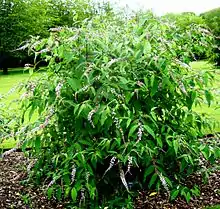Buddleja albiflora
Buddleja albiflora is a deciduous shrub native to the mountains of central China, where it grows on shrub-clad slopes at altitudes of between 1,000 and 2,000 m. Named rather carelessly by Hemsley, the species was discovered by Henry, and introduced to western cultivation by Wilson in 1900.[1]
| Buddleja albiflora | |
|---|---|
 | |
| Buddleja albiflora, Longstock Park Nursery, Hampshire | |
| Scientific classification | |
| Kingdom: | Plantae |
| Clade: | Tracheophytes |
| Clade: | Angiosperms |
| Clade: | Eudicots |
| Clade: | Asterids |
| Order: | Lamiales |
| Family: | Scrophulariaceae |
| Genus: | Buddleja |
| Species: | B. albiflora |
| Binomial name | |
| Buddleja albiflora | |
| Synonyms | |
| |
Description

Buddleja albiflora grows to a height of 4 m in the wild, the branches erect and glabrous. The leaves are narrow lanceolate, with a long-tapered point and wedge-shaped base, 10–22 cm long by 1–6 cm wide, toothed and dark-green, glabrous above in maturity, but covered beneath with a fine silvery-grey felt.[1] The shrub is similar to B. davidii, but has rounded stems, as opposed to the four-angled of the latter. Despite its specific name, the fragrant flowers are actually pale lilac with orange centres, borne as slender panicles 20–45 cm long by 5 cm wide at the base; they are considered inferior to those of B. davidii and thus the plant is comparatively rare in cultivation.[2] B. albiflora is hexaploid: 2n = 114.[3]
Cultivation
The shrub is fully hardy in the UK, and features in the NCCPG National Collection of Buddleja held by the Longstock Park Nursery, near Stockbridge.[4]
References
- Bean, W. J. (1981). Trees and shrubs hardy in Great Britain, 7th edition. Murray, London
- Leeuwenberg, A. J. M. (1979) The Loganiaceae of Africa XVIII Buddleja L. II, Revision of the African & Asiatic species. H. Veenman & Zonen, Wageningen, Nederland. .
- Chen, G, Sun, W-B, & Sun, H. (2007). Ploidy variation in Buddleja L. (Buddlejaceae) in the Sino - Himalayan region and its biogeographical implications. Botanical Journal of the Linnean Society. 2007, 154, 305 – 312. The Linnean Society of London.
- Moore, P. (2012). Buddleja List 2011-2012 Longstock Park Nursery. Longstock Park, UK.
- Stuart, D. (2006). Buddlejas. Plant Collector Guide. Timber Press, Oregon, USA. ISBN 978-0-88192-688-0
- Hillier & Sons. (1977). Hilliers' Manual of Trees and Shrubs, 4th Edition. David & Charles, Newton Abbot, England. ISBN 0-7153-7460-5.
- Li, P. T. & Leeuwenberg, A. J. M. (1996). Loganiaceae, in Wu, Z. & Raven, P. (eds) Flora of China, Vol. 15. Science Press, Beijing, and Missouri Botanical Garden Press, St. Louis, USA. ISBN 978-0915279371 online at www.efloras.org